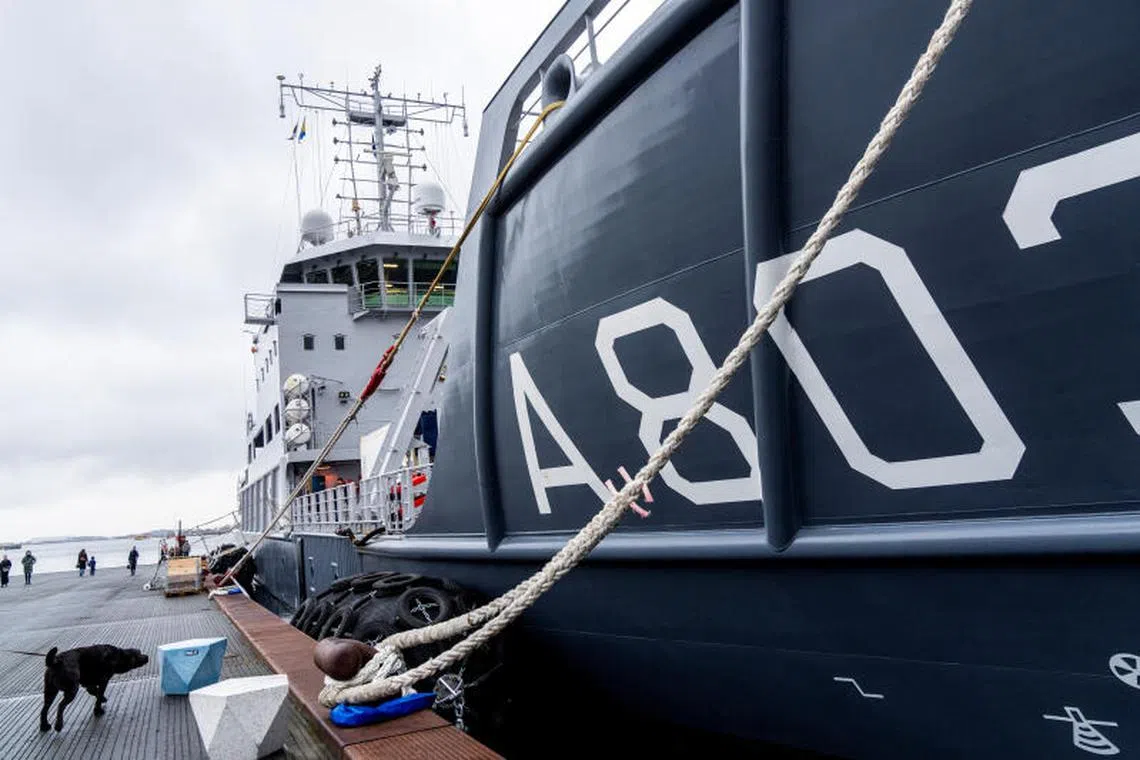Baltic undersea cable between Latvia and Sweden damaged by ‘external influence’
Sign up now: Get ST's newsletters delivered to your inbox

An anchor presumed to belong to the Eagle S tanker lies on the deck of HMS Belos in Finland.
PHOTO: REUTERS
Follow topic:
VILNIUS - An undersea fibre optic cable between Latvia and Sweden was damaged on Jan 26, likely as a result of external influence, Latvia said, adding its navy had dispatched a patrol boat to inspect a vessel suspected of involvement.
Two other vessels in the area were also subject to investigation, Latvia’s navy said.
“We have determined that there is most likely external damage and that it is significant,” Latvian Prime Minister Evika Silina told reporters following an extraordinary government meeting.
Latvia is coordinating with Nato and the countries of the Baltic Sea region to clarify the circumstances, she said separately in a post on X.
Up to several thousand commercial vessels make their way through the Baltic Sea at any given time, and a number of them passed the broken cable on Jan 26, data from the MarinTraffic ship tracking service showed.
One such ship, the Malta-flagged bulk carrier Vezhen, was closely followed by a Swedish coast guard vessel on Jan 26 evening, MarineTraffic data showed, and the two were heading in toward the southern Swedish coastline.
It was not immediately clear if the Vezhen, which passed the fibre optic cable at 12.45am GMT on Jan 26 (8.45am on Jan 26 in Singapore), was subject to investigation.
A Swedish coastguard spokesperson declined to comment on the Vezhen or the position of coastguard ships.
“We are in a stage where we cannot give any information,” the spokesperson said. “Exactly how we are involved we cannot say.”
Bulgarian shipping company Navigation Maritime Bulgare, which listed the Vezhen among its fleet, did not immediately reply when called and emailed by Reuters outside of office hours.
Nato cooperation
Swedish navy spokesperson Jimmie Adamsson told Reuters it was too early to say what caused the damage or if it was intentional.
“We don’t know, it’s too early in the investigation. We don’t even know if this is an accident or a fault in the cable,” he said, adding that Nato had primary responsibility for the investigation.

Nato naval vessel A803 is docked at the Ofelia Plads in Copenhagen Harbour, Denmark on Jan 26.
PHOTO: REUTERS
“Nato ships and aircrafts are working together with national resources from the Baltic Sea countries to investigate and, if necessary, take action,” the alliance said in a statement on Jan 26.
Swedish Prime Minister Ulf Kristersson said his country was cooperating closely with Nato and Latvia.
“Sweden will contribute important capabilities to the ongoing effort to investigate the suspected incident,” Mr Kristersson said on X.
Nato said last week it would deploy frigates, patrol aircraft and naval drones in the Baltic Sea to help protect critical infrastructure and reserved the right to take action against ships suspected of posing a security threat.
The military alliance is taking the action, dubbed “Baltic Sentry”, following a string of incidents in which power cables, telecom links and gas pipelines have been damaged in the wake of Russia’s invasion of Ukraine in February 2022. Finnish police in December seized a tanker carrying Russian oil and said they suspected the vessel had damaged the Finnish-Estonian Estlink 2 power line and four telecoms cables by dragging its anchor across the seabed
Finland’s prime minister in a statement said the latest cable damage highlighted the need to increase protection for critical undersea infrastructure in the Baltic Sea.
The cable that broke on Jan 26 linked the Latvian town of Ventspils with Sweden’s Gotland island, and was damaged in Sweden’s exclusive economic zone, the Latvian navy said.
Communications providers were able to switch to alternative transmission routes, the cable’s operator, Latvian State Radio and Television Centre (LVRTC), said in a statement, adding it was seeking to contract a vessel to begin repairs.
“The exact nature of the damage can only be determined once cable repair work begins,” LVRTC said.
A spokesperson for the operator said the cable, laid at depths of more than 50 metres, was damaged on early Jan 26 but declined to give an exact time of the incident.
Unlike seabed gas pipelines and power cables, which can take many months to repair after damage, fibre optic cables that have suffered damage in the Baltic Sea have generally been restored within weeks.
A Swedish Post and Telecom Authority spokesperson said it was aware of the situation but had no further comment. REUTERS

